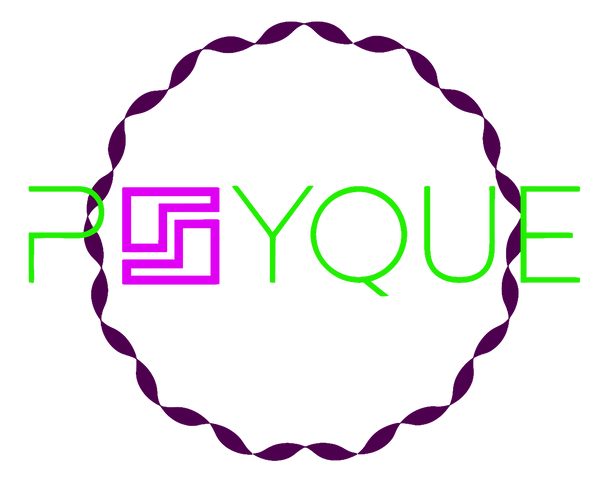
Find the Best DTF Near Me in the UK
Share
Typing "DTF near me" into a search bar is more than just a convenience—it's the starting point for creating top-tier, vibrant custom apparel without the headache of cross-country shipping. The best local DTF printers offer things you just can't get from a faceless online giant: fast turnarounds, the ability to review samples in person, and the chance to build a real relationship. It all adds up to a more professional finish for your projects.
Why Local DTF Printing Is Your Secret Weapon
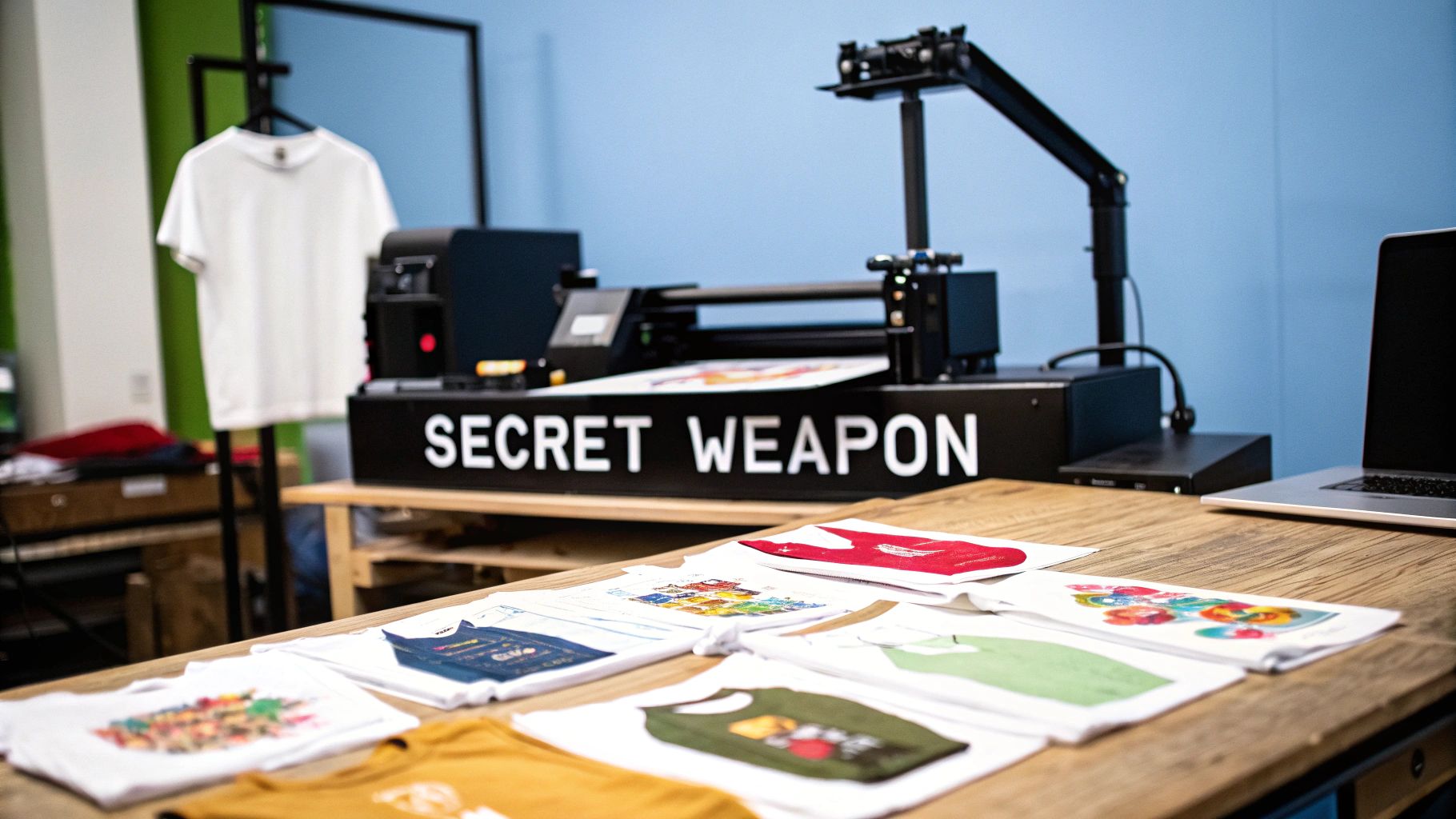
Before you get lost in a sea of search results, it's worth understanding why sticking with a local provider is such a smart move. Direct-to-Film printing has absolutely exploded in popularity here in the UK. It’s no longer a niche method; it's now the go-to for countless creators and businesses, especially for small to medium-sized runs where its quality and versatility really shine.
The global market for DTF printers was valued at around $667 million and is still climbing, a trend that’s easy to spot in the UK’s bustling textile scene. This growth is a clear signal that businesses are catching on to DTF's cost-effectiveness and adaptability. You can get a sense of the numbers from this comprehensive DTF printer market report.
But what does all this mean for you and your project? Simply put, working with a local DTF service turns what could be a sterile online transaction into a genuine collaboration.
The Tangible Benefits of Going Local
Choosing a nearby printer offers so much more than just convenience. It brings real, tangible benefits that have a direct impact on your final product and your wallet. Instead of anxiously tracking a package for days, you can often pop over and collect your transfers within hours, which can be a game-changer for your production schedule.
Here are a few of the biggest wins:
- Zero Shipping Delays or Costs: Forget the stress of courier mix-ups and save a good bit on postage. For any small business, those savings really start to add up.
- Hands-On Quality Control: Nothing beats seeing and feeling a physical sample. You can check the colours, feel the texture, and approve the application right there and then, making sure the final batch is absolutely perfect.
- Direct Communication and Expertise: Got a question about a tricky polyester blend? A local expert can give you advice on the spot, helping you dodge costly mistakes before they even happen.
- Support for Your Local Economy: Every time you choose a local business, you’re helping to strengthen the creative and commercial fabric of your own community.
Imagine this scenario: you land a last-minute order for 50 T-shirts for an event this weekend. A big national online service might have a three-day production queue before shipping time. A local printer, on the other hand, might just be able to squeeze your job in and have it ready for you to collect the very next day.
Building a Strategic Partnership
Perhaps the biggest advantage of all is the opportunity to build a proper relationship. A printer who gets to know your brand—your specific colour palettes, the garments you prefer, your quality standards—becomes an indispensable part of your team. This isn't just about finding a supplier; it’s about finding a partner who is genuinely invested in your success.
If you want to get a bit more technical, our complete guide on what DTF printing is all about is a great place to start. A strong local partnership ensures you get consistency and quality across all your future projects, giving you a reliable foundation to grow your brand.
Your Blueprint for Finding Local DTF Providers
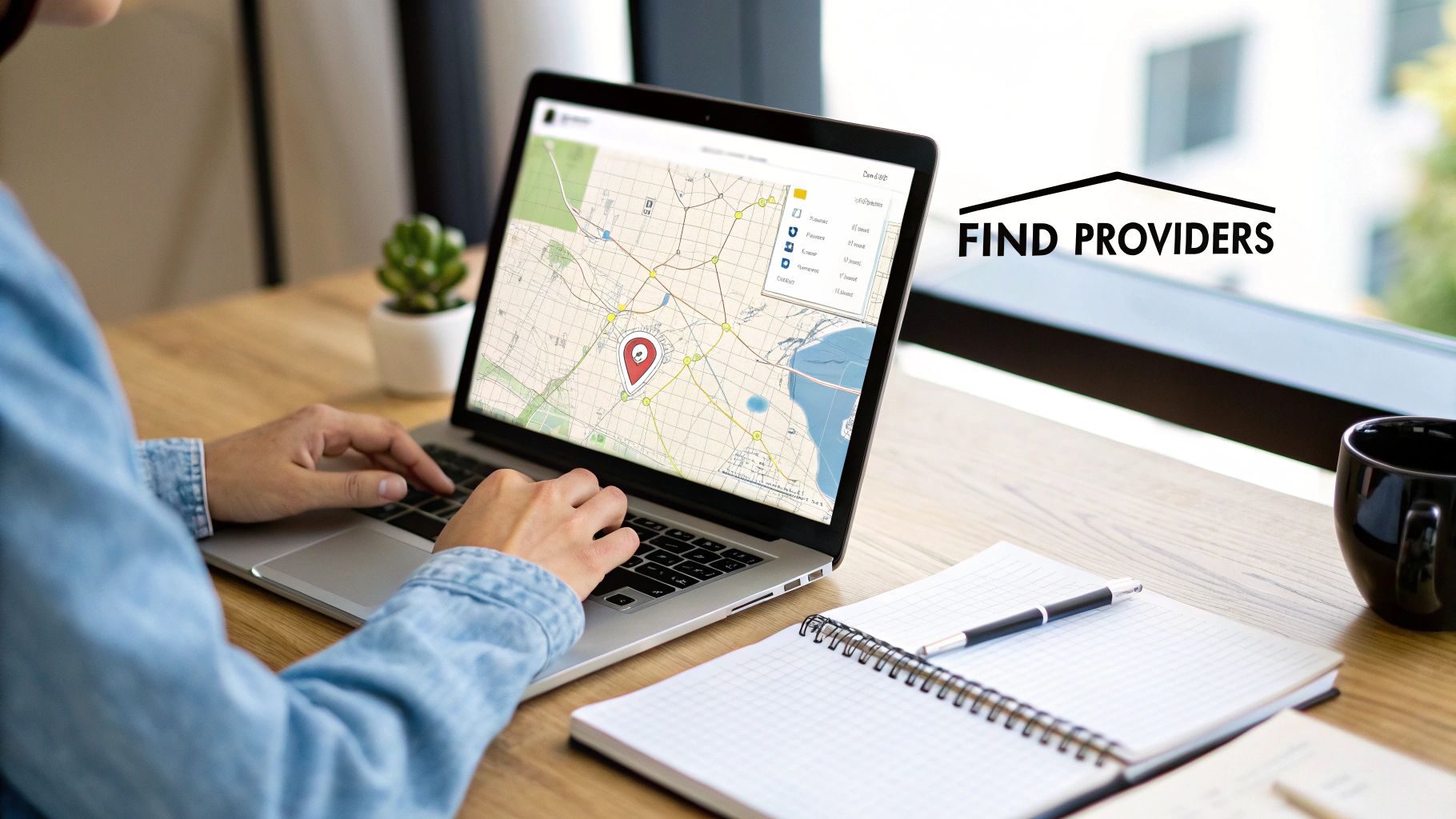
Alright, you’re sold on the idea of working with a local printer. So, where do you start?
Just firing up Google and typing "DTF near me" is the obvious first move, but if you want the best results, you'll need to be a bit more strategic. This first phase isn't about finding the one; it's about building a solid longlist of potential partners you can dig into later.
Your mission is to cast a wide net. You want to uncover both the big names and the hidden gems in your area. Don't just click the first ad you see—think of yourself as a detective, gathering clues to find the perfect printer for your next big project.
Go Beyond Basic Search Terms
Here's a little industry secret: while "DTF near me" is a decent start, it can be surprisingly restrictive. Many fantastic print shops offer DTF as part of a wider range of services but might not lead with that specific term in their marketing. To find them, you need to broaden your search.
Try searching for more general phrases, like:
- "Custom garment printing [your city]"
- "T-shirt printing services [your town]"
- "Local apparel customisation"
- "Workwear printing [your area]"
This simple tweak helps you find established businesses that have likely invested in DTF technology as they've grown. You can also explore options for general custom t-shirt printing near me, which often uncovers some really versatile providers.
Pro Tip: Switch over to Google Maps for your search. It gives you a visual layout of printers in your area and, more importantly, a direct line to customer reviews and photos. A quick scroll through the reviews can give you priceless insight into a company’s reliability and the quality of their work.
Tap into Your Local Network
Let's be honest, sometimes the best recommendations don't come from an algorithm but from a real person. Local community groups are an absolute goldmine for genuine, unfiltered advice from other small business owners and creatives who have already done the legwork.
Jump onto platforms like Facebook and search for local business networking groups, creative hubs, or even community noticeboards. Post a simple question asking for recommendations for a reliable DTF printer. You’ll be surprised how quickly you get honest feedback from people with firsthand experience. This kind of word-of-mouth intelligence is worth its weight in gold.
Once you’ve got a handful of promising names from your online searches and community recommendations, it’s time to get organised. A simple spreadsheet will do the trick. Just log each potential provider's name, website, and contact details, along with any initial thoughts. This list is your foundation for the next crucial step: vetting each one to find your perfect match.
How to Vet and Choose the Right DTF Printer
Okay, you've got a list of local contenders. Now for the important bit: figuring out who's actually good and who just has a flashy website. This is where you separate the real professionals from the pack.
You’re looking for a partner, not just a supplier. Their work will directly represent your brand, so it’s crucial to get this right. Think of it less like shopping and more like conducting an interview for a key team member.
Start With a Digital Deep Dive
Before you even think about picking up the phone, do some serious online reconnaissance. A well-put-together website is a good sign, but you're looking for substance, not just style. You need to see cold, hard proof of their skills.
Here's what I always look for:
- A Diverse Portfolio: Are they just showing off basic, one-colour logos on a standard tee? Or is there evidence of complex, vibrant designs on different types of garments? A solid portfolio proves they can handle more than just the easy stuff. Look for work on tricky fabrics.
- Genuine Testimonials: Vague quotes like "Great service!" don't tell you much. I want to see detailed reviews, preferably from businesses or creators in a similar space to mine. Specific feedback about a successful project is worth its weight in gold.
- Clear Service Information: How easy is it to find out what they actually do? Look for specifics on the fabrics they work with, preferred file formats (this is a big one!), or even the type of equipment they run. Transparency suggests they know their stuff and have a professional workflow.
This initial online check is a fantastic way to quickly weed out anyone who doesn't meet your quality standards from the get-go.
Ask Questions That Reveal True Capability
Once your list is narrowed down, it’s time to make contact. This is your chance to ask smart, targeted questions that go way beyond "What's your price?". The answers—or lack thereof—will tell you everything you need to know.
Forget generic questions. Get specific. Try these on for size:
- "What's your typical turnaround time for an order of 50 transfers?"
- "Could you show me a sample of a print you've done on a tri-blend or 100% polyester garment?"
- "What are your artwork requirements? Do you prefer vector AI files, or are high-res PNGs okay?"
Questions like these require a real answer, not just a yes or no. They kickstart a proper conversation about their process, their capabilities, and how much attention they pay to the details. A confident, knowledgeable response is a massive green flag.
When you're searching for any new creative partner, the core principles of vetting remain the same. This guide on how to choose a reliable service provider has some great universal tips that apply here, too.
This infographic breaks down the vetting process into three simple, effective stages.
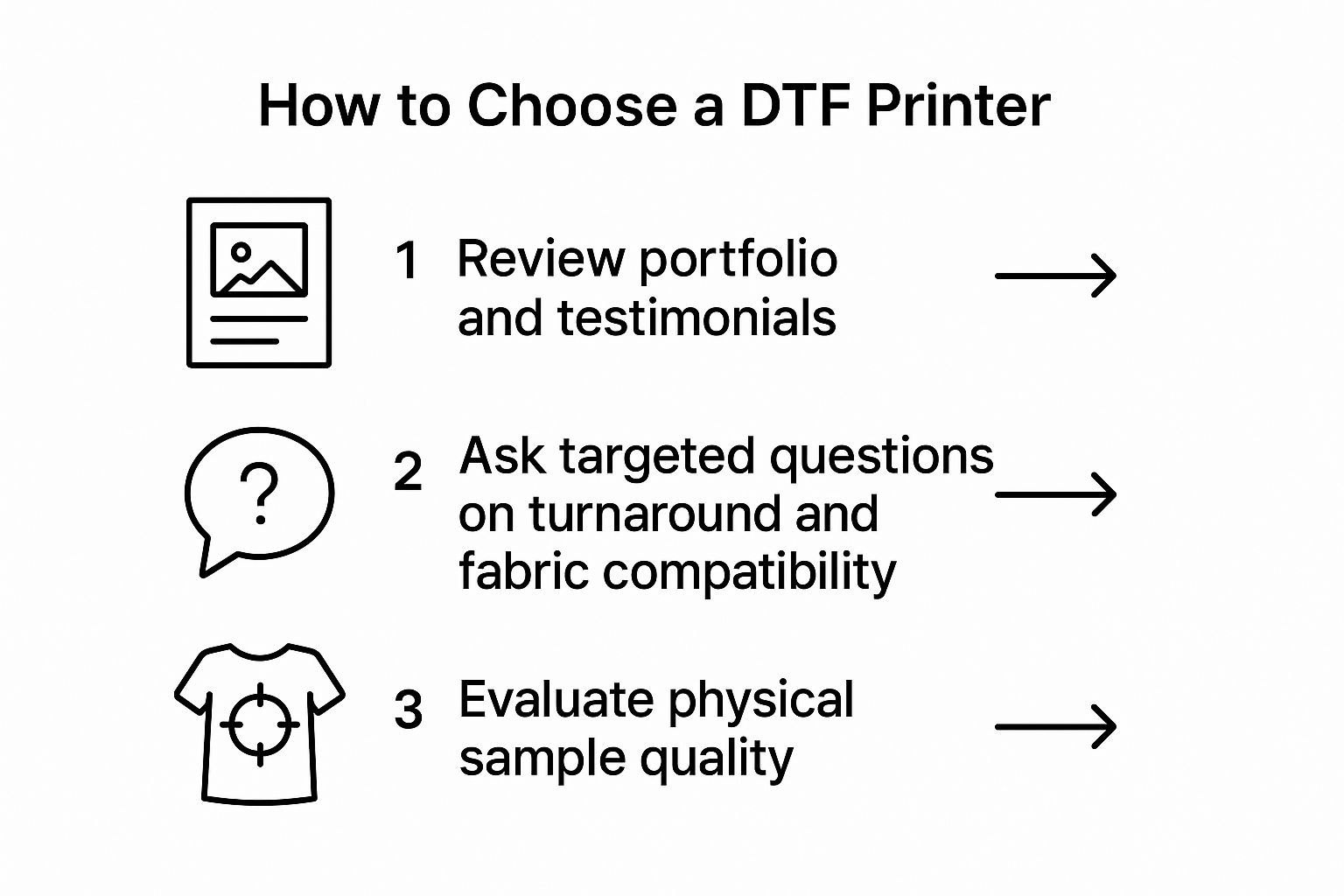
By systematically reviewing their work, asking insightful questions, and getting your hands on a physical sample, you're making a decision based on quality and reliability, not just promises.
The Ultimate Test: The Physical Sample
I can't stress this enough: never, ever commit without seeing and feeling the product for yourself. A digital mock-up can look perfect on screen, but a physical sample tells the whole story.
Ask for a sample print. Even if there's a small fee, pay it. Think of it as a tiny investment in your quality control. It's worth every penny.
When the sample arrives, give it a proper inspection. Check the colour accuracy against your digital file. Look closely at the print sharpness—are the edges crisp? Most importantly, how does it feel? A great DTF transfer should be soft and flexible, almost blending into the fabric. If it feels thick, stiff, or like a plastic sticker, that's a red flag.
This hands-on evaluation is the single most important step in finding the best local DTF printer for your project.
To get a better sense of what top-tier quality looks like, it helps to understand the broader world of custom t-shirt printers and the different results they produce. Ultimately, making your final choice based on a tangible product you've held in your own hands is the only way to guarantee your vision will be executed perfectly.
Local DTF Printer Vetting Checklist
Use this simple checklist as a scorecard to compare your top contenders side-by-side. It helps keep your thoughts organised and makes the final decision much clearer.
| Vetting Criterion | Printer A | Printer B | Printer C |
|---|---|---|---|
| Portfolio Quality (Variety & Complexity) | |||
| Testimonial Relevance & Detail | |||
| Website Transparency (File Types, etc.) | |||
| Response to Specific Questions | |||
| Turnaround Time Quoted | |||
| Sample Colour Accuracy | |||
| Sample Print Sharpness | |||
| Sample Feel (Softness/Flexibility) | |||
| Overall Professionalism |
Once you've filled this out, the right choice often becomes obvious. The printer with the best scores across the board is likely the reliable, high-quality partner you're looking for.
Decoding Quotes and Placing Your First Order
You’ve done the legwork, narrowed down your list, and found a local printer that looks promising. Brilliant. Now for the final hurdle: making sense of their quote and placing that first order without any last-minute jitters.
This stage can feel a bit overwhelming, but it’s really just about locking in the details to make sure what you get is exactly what you pictured.
DTF transfer pricing isn't always a straightforward cost-per-item. Most quotes are a mix of different charges, and getting to grips with them is the key to keeping your budget on track.
You’ll usually see a few common cost structures:
- Per-Print Fees: This is the basic cost for each transfer, typically based on its size. A larger design costs more than a small one. Simple.
- Setup Charges: Some printers will add a one-off fee to prep your artwork for their machines, particularly if it needs a bit of tweaking to be print-ready.
- Tiered Discounts: This is where you can really save. Nearly every printer offers a better per-print price when you buy in bulk. Ordering 100 transfers will always be cheaper per piece than just ordering 10.
Getting an Accurate Quote Without the Back-and-Forth
To get a quote that’s fast and, more importantly, accurate, you need to give the printer everything they need right from the start. Any guesswork on their part leads to delays and surprise costs later on. Being prepared doesn't just make you look professional; it helps them help you.
When you reach out, make sure your request includes:
- Your Artwork Files: Be clear about the file type. A vector file (like an Adobe Illustrator AI or EPS) is the gold standard because it can be scaled up or down without losing quality. That said, a high-resolution PNG—300 DPI is the industry benchmark—with a transparent background will usually do the job just fine.
- Print Dimensions: Don't just say "medium-sized." Give them the exact height and width in centimetres.
- The Quantity: How many transfers of this specific design do you need?
- Garment Deets: Let them know what you're pressing onto. The type of fabric and its colour are really important, as they can influence how the print turns out.
If you want to make sure you've covered all your bases, using a dedicated form to request a custom apparel quote can streamline the whole process.
Crucial Tip: For any decent-sized order, always, always ask for a physical sample. A digital mock-up on a screen looks perfect, but it tells you nothing about the print’s real-life texture, flexibility, or how vibrant the colours truly are once pressed. This one small step is the best way to avoid a whole lot of disappointment.
From Quote to Order
Happy with the quote and the sample? Fantastic. Placing the actual order is usually just a formality. You’ll confirm the final numbers, sort out the payment, and get a timeline for when your transfers will be ready.
Keep in mind that the world of personalised apparel is booming. The global DTF market is on track to hit USD 3.92 billion by 2030. This incredible growth is exactly why building a solid relationship with a reliable local DTF printer is so important. Clear communication is everything.
By taking a little extra care during the quoting process and insisting on a sample, you’ll sidestep the most common headaches. It puts you in control, letting you place your order with the confidence that the final product will be a perfect reflection of your brand’s quality.
Building a Strong Partnership with Your Printer
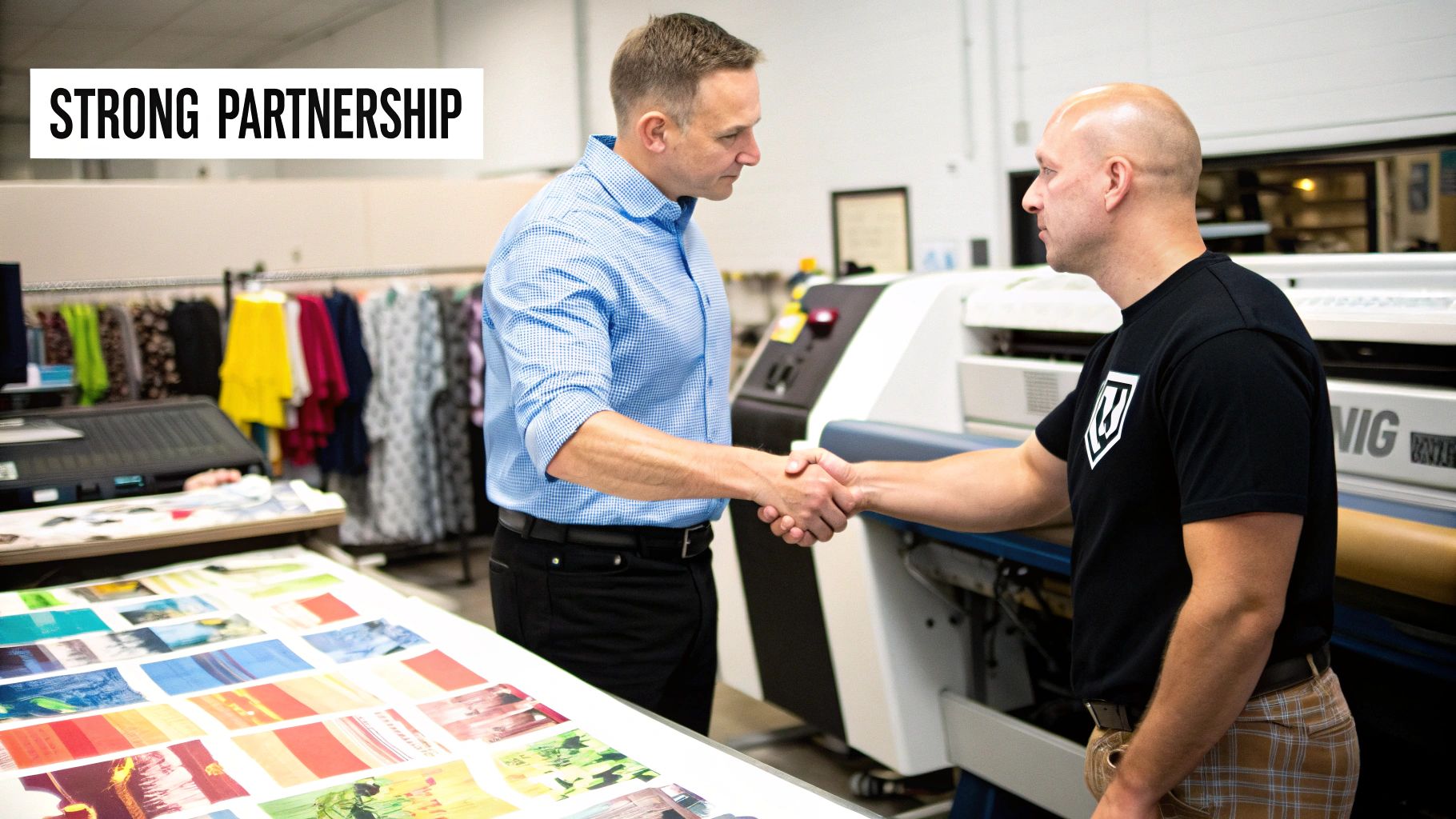
Finding a great local DTF printer is a huge win, but the real magic happens when you turn that first order into a proper long-term partnership. It’s about moving beyond just being another customer on their list.
When you shift from a simple transactional relationship to a collaborative one, your printer stops being just a supplier and becomes a genuine asset. This is where you start seeing benefits that go way beyond the cost of a single print run. A solid partnership is all about mutual respect and open communication.
Once your printer really gets your brand, understands your quality standards, and knows your typical order cycle, they can start thinking ahead for you. They can flag potential problems before they happen and suggest solutions, ensuring every order you place is consistently brilliant.
The Foundations of a Great Printer Relationship
Start thinking of your printer as an extension of your own team. Like any good professional relationship, it needs clear communication and shared goals to really work. This isn't just about being friendly—it's about getting into a rhythm that makes every project go off without a hitch.
A few simple practices can make a world of difference:
- Provide Clear, Constructive Feedback: If a sample isn't quite right, be specific about why. Instead of just saying "the colour is off," try something like, "the red feels a bit too orange; can we get it closer to Pantone 186 C?" Actionable feedback is gold.
- Respect Their Lead Times: One of the best things about a local printer is their flexibility for those inevitable rush jobs. But whenever you can, give them a decent heads-up on upcoming projects. It helps them schedule their workload and makes sure your job gets the focus it deserves.
- Keep Your Artwork Organised: Always, always send your files in the format and size they ask for. It’s such a simple thing, but it saves a ton of time and cuts out all that pointless back-and-forth.
A printer who knows you and your work is far more likely to go the extra mile. They might spot a potential issue with a new design file or suggest a slightly different print size that would look way better on the final garment. That kind of insight is priceless.
Unlocking the True Value of Loyalty
Sticking with a reliable local "DTF near me" service does more than just make ordering easier; it brings tangible benefits that can seriously help your bottom line. As you build up a history of consistent orders, you stop being just another job number and become a valued client.
This can lead to some real-world advantages. Think priority scheduling when things get hectic, better pricing on bulk orders, and a partner who’s willing to experiment with you on that tricky new project.
Ultimately, they become invested in your success because when you grow, they grow. This kind of partnership becomes a strategic tool, helping your brand produce top-quality gear reliably and efficiently.
Got Questions About Local DTF Printing? Let's Clear a Few Things Up
Right, so you've done the legwork and are close to picking your local DTF partner. This is usually the point where a few practical questions pop up. Getting these sorted will give you that last bit of confidence you need to press go on your project.
Let's run through some of the most common things people ask when they're searching for "DTF near me." Nailing down these details early on helps everyone stay on the same page and makes for a much smoother ride.
What’s the Minimum Order I Can Place?
This is a big one, especially if you're a small business, a solo creator, or just testing the waters with a new design. One of the best things about DTF is how flexible it is with order sizes. It’s a world away from screen printing, where you often need to commit to 25-50 items just to make the setup costs worthwhile.
The great news? Many local DTF printers have no minimum order quantity (MOQ) at all. Seriously. You can order a single transfer to sample a new design or create a one-off custom piece without any fuss. For bigger runs, you'll usually find they offer tiered pricing, so the more you order, the less you pay per transfer. It’s a win-win.
How Well Do DTF Prints Actually Last?
Durability is a deal-breaker, and thankfully, DTF prints are seriously tough. When it's pressed correctly, a quality DTF transfer can handle 50-100 washes (and often more) before you'll see any major fading, cracking, or peeling. The ink doesn't just sit on top; it chemically bonds with the fabric fibres, creating a print that’s both vibrant and flexible enough to move with the garment.
Compared to screen printing, DTF offers pretty much the same level of durability but with the massive bonus of unlimited colours and detailed gradients. It also generally outlasts heat transfer vinyl (HTV), which can feel a bit thick on the shirt and is more likely to crack over time with lots of stretching and washing.
What’s the Best File Format for My Artwork?
To get those crisp, eye-popping results you're after, your artwork file needs to be spot-on. Printers can often work with a few different formats, but there are definitely some gold standards you should aim for.
- Vector Files (.ai, .eps, .svg): These are the holy grail. Vector graphics are built with maths, not pixels, which means they can be scaled up to the size of a bus without losing a shred of quality.
- High-Resolution Raster Files (.png, .psd): If you don't have a vector file, a high-res PNG with a transparent background is the next best thing. You'll want to aim for 300 DPI (dots per inch) at the exact size you want the final print to be.
Handing over the right file type from the get-go saves a ton of back-and-forth and ensures you don't end up with a blurry, pixelated mess. If you want to get into the nitty-gritty of what makes a file print-perfect, have a look at our guide to achieving stunning DTF prints.
What Kind of Fabrics Can I Print On?
This is where DTF really shows off. Its versatility is a huge part of why it's become so popular. Of course, it works brilliantly on your standard 100% cotton and polycotton blends, but it doesn't stop there.
DTF is a champ on a massive range of materials, including:
- 100% Polyester (perfect for sportswear)
- Tri-blends
- Canvas (think tote bags and aprons)
- Denim
- Even tricky stuff like some treated leathers and nylons
This adaptability just blows the doors wide open for creativity. You can brand everything from your classic tees to jackets, hats, and all sorts of accessories with consistent, top-quality results.
Ready to bring your designs to life with a reliable UK-based partner? Psyque - DTF Print & Press offers premium, ready-to-press transfers and custom apparel with fast, tracked shipping. Explore our collections or request a custom quote today at https://psyque.co.uk.
